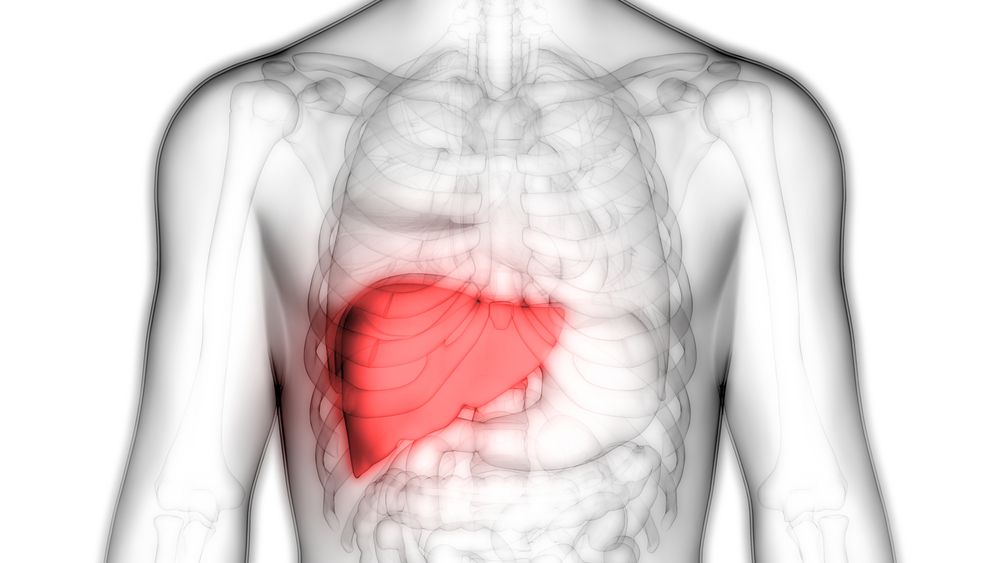Liver Disease Prevalence in EPP Similar to General Population

Magic mine/Shutterstock
The prevalence of advanced liver disease — including fatty liver disease — in patients with erythropoietic protoporphyria (EPP) is similar to that of the general population, according to a new Dutch study.
Investigators also noted that the levels of protoporphyrin IX or PPIX, a heme precursor that tends to build up to toxic levels in EPP patients, seem to be associated with liver stiffness and might help assess a person’s risk of developing liver scarring.
The study, “Liver involvement in patients with erythropoietic protoporphyria,” was published in the journal Digestive and Liver disease.
EPP, the most common form of childhood porphyria and the third most common in adulthood, is caused by mutations in genes involved in the production of heme, a molecule essential for red blood cells’ oxygen transport and the breakdown of compounds in the liver.
These mutations result in the accumulation of porphyrins, including PPIX, in red blood cells and other tissues. Porphyrins can react to sunlight, causing pain and damage to several organs, such as the liver. This in turn also increases the risk for gallbladder stones, known medically as cholelithiasis.
Estimates indicated that 5–20% of EPP patients develop liver manifestations, ranging from mild disturbances to acute hepatitis (liver inflammation) and liver failure. However, such information was mostly derived from single-center studies with a biased selection for certain patients.
In this study, a team led by researchers at the University Medical Center Rotterdam, in the Netherlands, evaluated the prevalence of liver disease and its associated risk factors in a large group of EPP patients.
Liver health was assessed using two methods: ultrasound with transient elastography, which is commonly used to measure liver stiffness, and blood tests.
In total, the study included 114 adults with EPP, who had a mean age of 41.2. A little less than half (45.6%) of the participants were men. All attended the outpatient clinic of the Porphyria Center Rotterdam in the Erasmus MC.
A normal body mass index (BMI), a measure of body fat, was found among more than half (52.5%) of the patients. Yet, 27.3% were deemed to be overweight and 20.2% were obese.
Seven patients (6.2%) had elevated levels of liver enzymes — an indication of liver damage and inflammation. Four of these patients were being treated with afamelanotide, a medication marketed under the brand name Scenesse that protects the skin against the effects of sunlight.
Anemia was found in 27.4% of the patients, while 44.4% had an enlarged spleen (splenomegaly). Low platelet counts were seen in 8.1%
The median levels of PPIX were 40.0 micromoles per liter (umol/L). At the time of transient elastography, 57.9% of the patients were being treated with Scenesse, with a median duration of 1.8 years).
Ultrasound analyses revealed that 28 patients (25.7%) had gallbladder stones or had experienced them in the past. From these, 18 (64.3%) underwent surgery to remove the gallbladder.
In total, 18 out of 62 patients (29%) were diagnosed with fatty liver (steatosis). Liver stiffness measurements were available for 104 patients and showed that 10 (9.6%) had increased stiffness, suggestive of liver scarring, or fibrosis.
A statistical analysis showed that PPIX levels were independently associated with liver stiffness, after adjusting for factors such as BMI.
In addition, the researchers found that PPIX levels were positively associated with age and gamma-glutamyl transferase (GGT), an enzyme that when found in the bloodstream may indicate the presence of liver disease.
Moreover, hemoglobin levels and platelet counts were both negatively correlated with PPIX levels in EPP patients. Of note, hemoglobin is the protein in red blood cells that is responsible for transporting oxygen.
In this group of patients, the prevalence of non-alcoholic fatty liver disease was comparable to the general Dutch population. In addition, no significant differences in liver stiffness were observed between EPP patients and the general population when using similar test cut-off values.
Although the prevalence of cholelithiasis was slightly higher among EPP patients compared with the general population, investigators argued that this could be explained by the fact that ultrasounds are routinely performed in patients, possibly resulting “in a higher detection rate or incidence of asymptomatic cholelithiasis.”
Finally, researchers investigated the possible link between genetic mutations and liver involvement. They found 109 mutations in the FECH gene — whose mutations cause EPP — in 114 patients. Yet, these did not seem to influence steatosis, liver stiffness, or PPIX levels.
“The results of the present study demonstrate a prevalence of advanced liver disease in the adult patients with EPP that is comparable to the general population,” the researchers wrote.
“PPIX levels are likely to play a role in developing liver stiffness in patients with EPP. Longitudinal data of this cohort remain pivotal for future risk estimates of liver disease,” they concluded.








